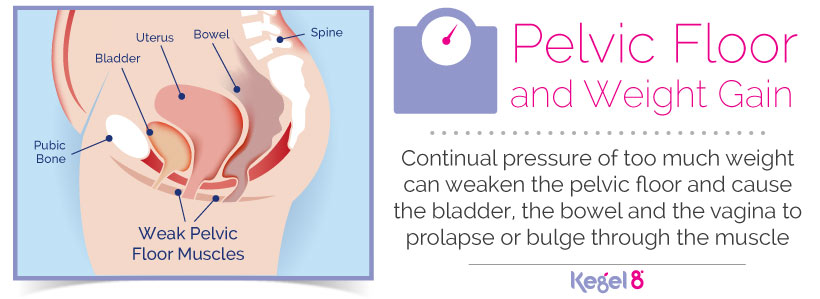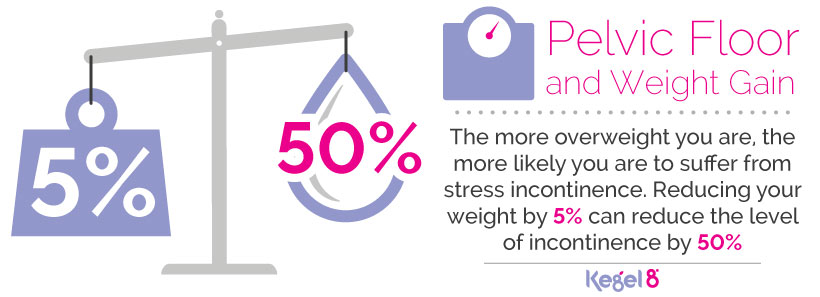
Pizza. Noodles. Curry. Fajitas. Is your mouth watering yet? Now and again we all like to treat our taste buds to a cheat day. But what happens when your cheat day turns into a cheat week, or month, or year..?
It won’t be long until you notice that you may have piled on a few pounds. But if you keep supplying your demanding tummy with whatever it desires, then you may find yourself on the dangerous side of the scale.
11th October marks the 4th annual World Obesity Day. Run by the World Obesity Federation, the campaign aims to stimulate and support practical solutions to help people achieve and maintain a healthy weight, and to reverse the obesity crisis. This year the campaign focuses on changing and ending obesity stigma once and for all.
If you think about the conditions associated with obesity, what do you imagine? Heart disease, stroke? One condition that is often left out of this narrative is the effect of obesity on the pelvic floor.
How Does Obesity Affect the Female Pelvic Floor?
Tam Fry, the leading spokesperson for the National Obesity Forum, sheds light on an alarming trend. Over the past four decades, obesity rates have soared, with a staggering 20% increase in men and over 25% in women. Various factors contribute to this surge: excessive calorie consumption, poor dietary habits, sedentary lifestyles, genetic predispositions, and certain medical conditions. However, an often-overlooked repercussion of these rising numbers is the heightened risk of pelvic floor disorders.
The link between obesity and pelvic floor issues is evident. Overweight and obese individuals are more prone to developing disorders. This is how it can affect women:
- Incontinence - Your bladder and bowel can become difficult to control if you have gained weight. This may cause you to experience embarrassing leakage. The more overweight you are, the more likely you are to suffer from stress incontinence. Obesity can also worsen the symptoms of an overactive bladder; you may find yourself going to the toilet more often and during the night and may also suffer some leakage before you reach the toilet.
- Pelvic Organ Prolapse - 1 in 12 women in the UK report symptoms of pelvic organ prolapse. Prolapse is very common in overweight women and gets progressively worse with time. Being overweight means that you carry more excess weight. This extra weight can cause more pressure to be forced upon your pelvic floor and its muscles. This continual, heavy load can weaken these muscles and eventually allow pelvic organs to droop down and bulge through the muscle.

How does Obesity Affect the Male Pelvic Floor?
Obesity can have significant effects on a man's pelvic floor, much like it does in women. The increased weight and pressure on the pelvic region can lead to several complications. Here's how obesity impacts a man's pelvic floor:
Increased Intra-abdominal Pressure: The excess weight, especially in the abdominal region, exerts more pressure on the pelvic floor muscles. This chronic pressure can weaken these muscles over time, making them less effective in their supportive and sphincteric roles.
Urinary Incontinence: Weakened pelvic floor muscles can lead to stress urinary incontinence. Men might experience leakage of urine during physical activities like coughing, sneezing, lifting, or even standing up. Obesity also increases the risk of urge incontinence, where there's a sudden urge to urinate.
Erectile Dysfunction (ED): Obesity can lead to or exacerbate erectile dysfunction. While the direct link between ED and pelvic floor dysfunction is still being studied, there is evidence that strengthening the pelvic floor muscles can help in managing ED.
Aggravation of Prostate Issues: Men with prostate problems, especially benign prostatic hyperplasia (BPH), might experience exacerbated symptoms due to obesity. The weakened pelvic floor might not provide adequate support, leading to increased urinary symptoms.
Lower Back Pain: The pelvic floor muscles work in conjunction with the lower back and abdominal muscles. A weakened pelvic support system can contribute to or exacerbate chronic lower back pain.
Bowel Issues: Just as with urinary incontinence, weakened pelvic muscles and increased intra-abdominal pressure can lead to fecal incontinence or chronic constipation.
Reduced Physical Activity: Due to the physical discomfort and potential embarrassment from incontinence, men might become less physically active. Reduced activity can further weaken the pelvic muscles and contribute to other health issues.
Increased Risk of Hernias: The added pressure on the abdominal and pelvic regions can also increase the risk of developing hernias, particularly inguinal hernias.
Overall Impact on Quality of Life: The combination of urinary issues, erectile dysfunction, and other related problems can significantly impact a man's quality of life, affecting his emotional well-being, relationships, and daily activities.
It's important to note that while obesity is a risk factor, not all obese men will experience these issues, and many of these conditions are treatable. Weight management, physical therapy focusing on the pelvic floor, and other interventions can help in managing and alleviating these problems.
How Does Obesity Affect the NHS?
Not only are these problems a huge cost to your health, but they also take a lot of money out of the NHS wallet. Obesity costs the NHS at least £5.1 billion and tens of billions to the UK society every year. This could pay for:
- The salary of 163,000 nurses
- The cost of performing 115,000 heart transplants
- The cost of 959 top-level new air ambulances
- An annual salary at the Living Wage level for nearly 310,000 people
- £78 to every single person in the UK
How Can You Prevent Pelvic Floor Disorders?
There are two main ways to effectively prevent pelvic floor disorders if you are overweight or obese; these include:
- Losing weight - is one of the most effective ways of preventing pelvic floor disorders when you are overweight or obese. Imagine yourself as your pelvic floor muscles, it’s much easier to lift 1 stone than 5 isn’t it? Women who lose 10% of their body weight can reduce their leakage by 50%.
Prolapse, however, is a more difficult matter. Being overweight or obese is associated with the progression of pelvic organ prolapse, however weight gain that has caused damage to your pelvic floor may be irreversible. This may deter you from doing anything about the problem, but losing weight has the possibility to stop the prolapse from worsening. - Kegels – The first-line treatment for improving pelvic floor disorders is pelvic floor muscle training. Try performing 10 fast Kegels and 10 slow Kegels 3 times a day to strengthen your pelvic floor. If you’re finding it difficult to locate and exercise those vital muscles, try enlisting Kegel8’s help through the Ultra 20 Electronic Pelvic Toner. The Kegel8 toner even has clinically designed programmes to help you target specific pelvic floor problems.

Tam Fry, chairman of the National Obesity Forum has said that: "The skeleton is perfectly designed to cope with a healthy weight. But if you're excessively heavy or obese, hips, knees and ankles may all suffer. Excess weight can be particularly damaging to your pelvic floor, which supports all of your crucial internal organs. The National Obesity Forum fights to raise awareness of how obesity can be detrimental to your health and wellbeing. "

So, What Should You Do Now?
Losing weight and strengthening your pelvic floor muscles are an effective way of repairing any pelvic floor damage as a result of being overweight or obese. By 2025, it is estimated that 2.7 billion adults will suffer from overweight and obesity worldwide. So, start making improvements to your health today and see how well you’ve progressed by World Obesity Day 2019!
For further information about losing weight safely visit the NHS treatment page here, or visit your local GP. To learn more about World Obesity Day, follow this link.
Sources
[1] Cooper, J., et al. (2015) Prevalence of genital prolapse symptoms in primary care: a cross-sectional survey. International Urogynecology Journal. 26(4), pp. 505-510.
[2] Department of Health (2016). Reference Costs 2015-2016 [online]. Department of Health [viewed 15/09/2018]. Available from https://www.gov.uk/government/uploads/system/uploads/attachment_data/file/577083/Reference_Costs_2015-16.pdf
[3] Living Wage Foundation (2018) What is the Living Wage as an Annual Salary? [online]. Living Wage [viewed 20/09/2018]. Available from https://www.livingwage.org.uk/what-living-wage-annual-salary
[4] McKinsey Global Institute (2014) Overcoming Obesity: An Initial Economic Analysis [online]. McKinsey & Company [viewed 20/09/2018]. Available from https://www.mckinsey.com/~/media/McKinsey/Business%20Functions/Economic%20Studies
%20TEMP/Our%20Insights/How%20the%20world%20could%20better%20fight%20obesity/MGI_Overcoming_obesity_Full_report.ashx
[5] National Association For Continence (2018) Diet and Exercise for Good Bladder Health [online]. NAFC [accessed 22/08/2018]. Available from https://www.nafc.org/diet-and-exercise/
[6] NHS (2016) Overview Obesity [online]. National Health Service [viewed 20/09/2018]. Available from https://www.nhs.uk/conditions/obesity/
[7] NHS Digital (2016). NHS Staff Earnings Estimates. Estimates to September 2016, Provisional statistics [online]. NHS Digital [viewed 20/09/2018]. Available from http://content.digital.nhs.uk/catalogue/PUB22697/nhs-staff-earn-sept-16.pdf
[8] Office for National Statistics (2017) Overview of the UK Population March 2017 [online]. ONS [viewed 20/09/2018].
[9] Penine Acute Hospitals NHS Trust (2015) Obesity and its Effects on the Pelvic Floor [online]. PAT NHS [accessed 22/08/2018].
[10] Scarborough, P., Bhatnager, P., Wickramasinghe, K.K., et al. (2011) The Economic Burden of Ill Health due to Diet, Physical Inactivity, Smoking, Alcohol and Obesity in the UK: An Update to 2006/07 NHS Costs. Journal of Public Health (Oxon). 33(4), pp. 527-535.
[11] World Obesity (2018) World Obesity Day 2018 [online]. World Obesity [viewed 20/09/2018]. Available from https://www.worldobesity.org/what-we-do/action-initiative/aiprogrammes/world-obesity-day/
[12] World Obesity Day (2018) World Obesity Day 11 October 2018 [online]. Obesity Day [viewed 20/09/2018]. Available from https://www.obesityday.worldobesity.org/








